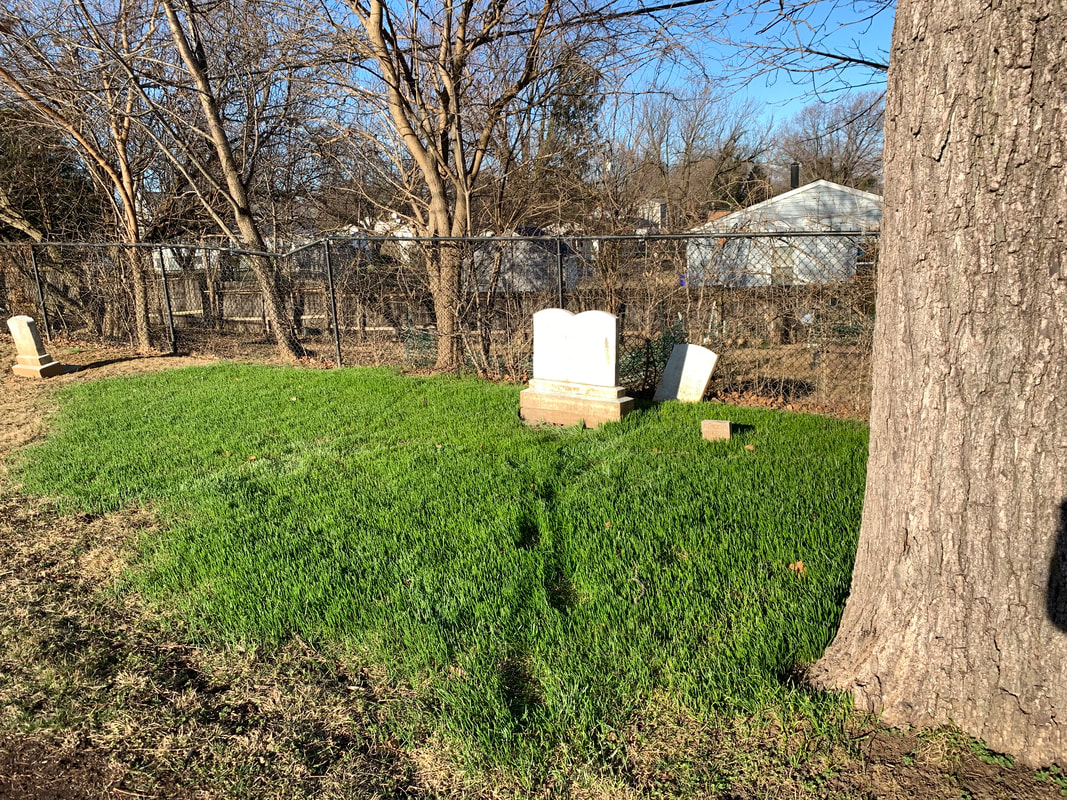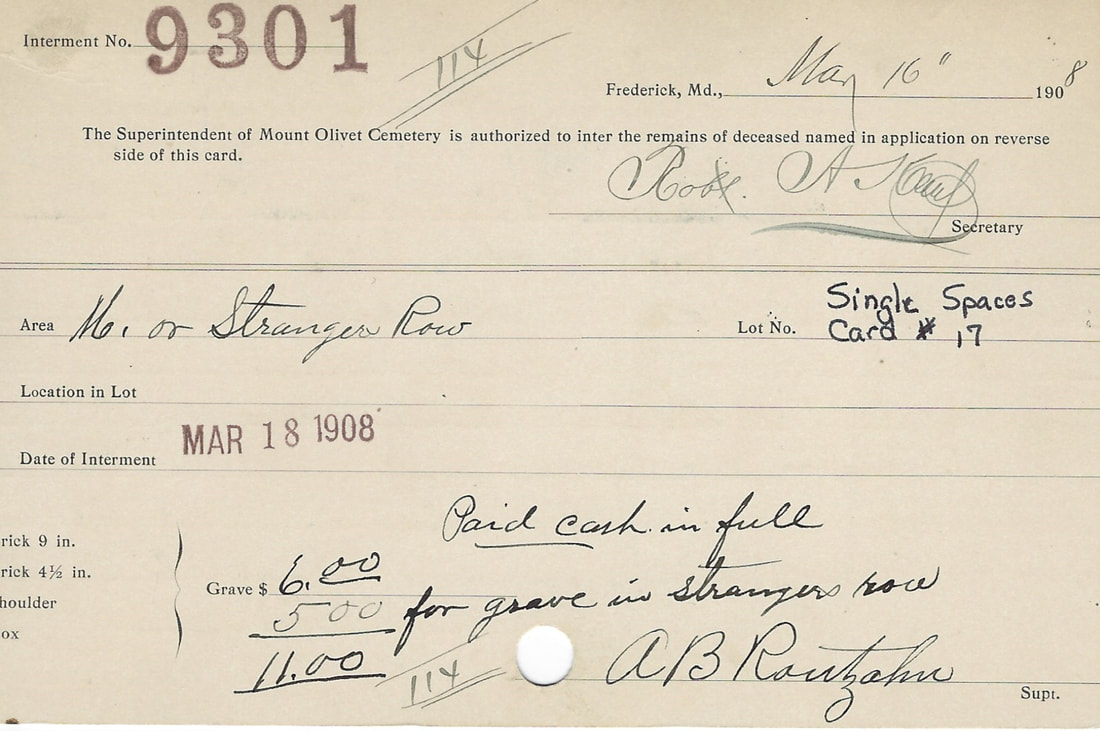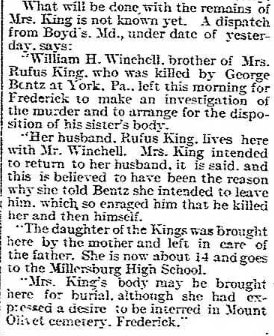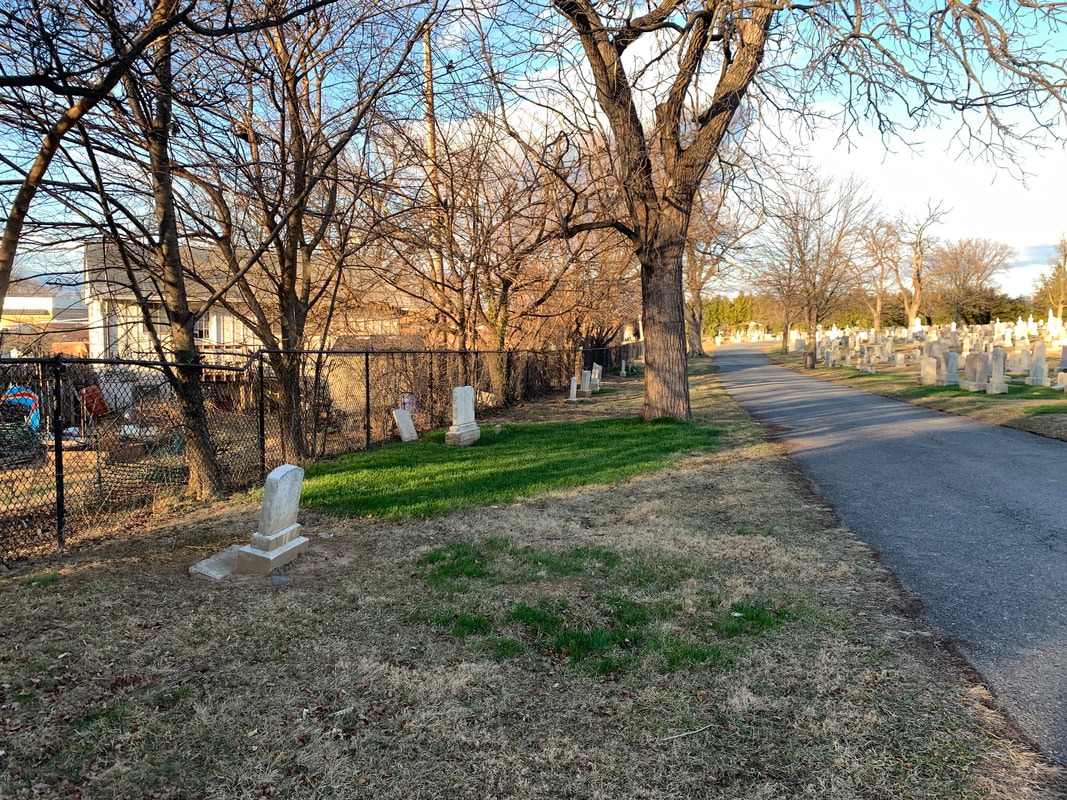|
It’s early February, pre-Valentine’s Day Weekend, to boot. The sun is shining and the weather is uncharacteristically spectacular. No snow, no sleet, no blustery winds. As I took a late-night walk after midnight, much earlier this morning, the temperature was 61 degrees, and the ground was glistening with moisture because the difference in ground and air temperature. I enjoyed much of the same state of affairs again, with a morning run taken at 7:30am. Not long after, a funny thing happened to me on the way to the mausoleum, where my work office is located here within Mount Olivet Cemetery. My eye was caught by something other than a gravestone, or monument this time. I had taken the driveway that runs adjacent to our western perimeter of the cemetery and appearing out of nowhere, I saw the most beautiful oasis of green. I casually breezed by this colorful spot in lonely old Area M, located in a plot not far from the northern beginning of “Confederate Row,” where nearly 700 soldiers from southern states repose—their lives cut short thanks to the American Civil War. The particular part of Area M that I am referring to with my morning optical surprise was actually commonly called “Strangers Row,” the topic of a “Story in Stone” I wrote in early January, 2023 about town lamplighter William “Uncle Billy” Hilton. Over a century ago, this was a place designated for burials of destitute individuals and unknown guests to town who unfortunately expired while here and far from family and native homes. Most laid to rest here have never been given a gravestone, simply because family was not here locally, or individuals that were such as a widowed spouse, orphaned children, a sibling or parent had no means to do so. I felt the immediate urge to turn back and reinvestigate this “strange” observance in “Stranger’s Row.” I navigated my trusty Jeep Liberty around at the first opportunity of a side lane. As I reached my “former” position, I knew for sure that my weary eyes had not deceived me. It was as bright and eye-opening as I can recall the foundation of a delightfully-filled basket of candy on Easter Sunday morning in my childhood. This was a true spring-like experience. My brain, the strange machine it is, also immediately conjured up the very first time I saw Astroturf while attending a game at Philadelphia’s Veteran Stadium in the late 1970s. Now this was a Phillies baseball game, and not an Eagles game, which I would see on plenty of occasions later as well. Seems fitting, as many will think of that old sports venue late this weekend as the Eagles play the Chiefs in the Super Bowl. Could my green, here in Mount Olivet, be a sign that the Eagles may be victorious on Sunday? I walked closer to the few gravestones among the lush green grass I’m talking about. I would eventually learn from our interment database that this location is Area M/Lot 27. I was familiar with this terra-firma, albeit a little softer than I recall it being five weeks earlier when visiting Lot 26 next door in subfreezing, windy conditions (while compiling my research for the William Hilton story referenced earlier). The age-old idiom naturally came to mind instantly: The grass is always greener on the other side. I tried to find special symbolism here on this interesting winter day that feels anything but. I also thought about the mystique attached to many in this section of Area M, including all our Rebel soldiers who I’m sure never would have guessed that their final resting places would be in a town named Frederick, Maryland.  As I started writing this piece, I felt the need to check the idiom and proverb again, because I seem to be guided to this location by divine intervention this morning, within a week where I have done a lot of self-reflection and soul-searching myself. No need to get into any of that here, but I will say that the proverb at hand comes with a great deal of irony. Upon deeper investigation, I learned that the expression has actually been shortened in modern usage, as it began as “the grass is always greener on the other side of the fence.” We have also created a well-used “variant,” with “the grass isn’t always greener on the other side,” and/or “the grass may not be greener on the other side.” Whatever the iteration, the message is the same as it is used to say that the things a person does not have or desires always seem more appealing than the things he or she does have, or the opposite of thinking that what you desire may not be better than what you already have. Oh desire, temptation and envy, why must you prod? In other words, we are always tempted by and envious of what other people have. This whole exercise has now made me understand another old saying, “green with envy.” The phrase dates back to the Greek poet Ovid, who lived in the first century B.C. The original saying was, “The harvest is always richer in another man’s field.” The proverb as we know it comes from an American folk song titled: “The Grass Is Always Greener in the Other Fellow’s Yard.” This was written by Raymond B. Egan and Richard A. Whiting in the year 1924. The chorus reveals our answer: The grass is always greener In the other fellow’s yard. The little row We have to hoe, Oh boy that’s hard. But if we all could wear Green glasses now, It wouldn’t be so hard To see how green the grass i In our own backyard. I only found four stones in Lot #27 of Area M, within the center of what appeared to be “the sea of bright green” that I’ve been gushing about. Now, I will be very careful bringing humorist writer Erma Bombeck into our story, because she hinted to the “green grass” proverb with her 1976 classic The Grass is Always Greener Over the Septic Tank. While this funny take provides a great deal of truth, I can say with certainty that there are no septic systems here beneath the cemetery proper, instead just people from our past—12 to be exact in this particular grave lot. I would later learn that one of these was an interloper, in gravestone only. The marble tombstone leans against the chain-link, cemetery fence and shouldn’t even be at this location. It reads Thomas J. Bell. Mr. Bell was a gentleman who died at 62 years of age and lived at 161 B & O Avenue at the time of his death. His stone belongs over his (body) which is in Lot 26, just to the south. The prominent monuments of Lot 27 are few, as mentioned earlier. There are only three here representing a group of 12 individual grave spots. The centerpiece includes a tandem of marble offerings, mounted on the same base. Here, we find husband and wife, Jacob C. Sinn (1813-1860) and Permelia F. (Cole) Sinn (1820-1885), who I learned were married on March 19th, 1836. Our cemetery database provided a few tidbits on each of these decedents who were originally buried in the German Reformed Graveyard on the northwest corner of the intersection of North Bentz and West Second streets. I purposely didn’t say “former graveyard,” as many of the Sinn’s Reformed brethren (nearly 300) are still buried at the familiar site we know as Memorial Park. Decedents still lie underneath the various monuments dedicated to local residents who participated in 20th century wars. I guess you could say that the Sinns were reinterred to the “greener pastures” of Mount Olivet and Area M/Lot 27 on April 21st, 1910. That also seems like a date more fitting of having such a colorful array of ground cover than February 10th. Our records show that the Thomas P. Rice undertaking business of town performed the honors. A son of Phillip Henry Sinn and wife Mary Elizabeth (Lare), Jacob Sinn was born on May 8th, 1813. He had a career as a cabinet-maker and served as a member of the Order of Odd Fellows fraternal organization. He also was the Sexton of Frederick’s German Reformed Church, a position that entailed the holder to look after the church and churchyard, sometimes acting as bell-ringer and formerly as a gravedigger as a common description cites. Speaking of gravedigging, Mr. Sinn would be the recipient of two. The first came when our subject died on January 14th, 1860 and was spared having to witness the carnage of the American Civil War, some of which is laid out in a long row just a few yards to the south as I explained earlier. As for Permelia, her name alone deserves some exploration. Do you know anyone having this moniker? It is of Greek origin and translates to “all sweetness.” A variant form of this name found today is Pamela. Other records associated with Frederick’s German Reformed Church also show this woman’s name as Emily Ann. Regardless, our records say that Permelia was the daughter of James Cole and a mother with the maiden name of McNally. All I can tell you about this woman is that she passed on July 3rd, 1885 from congestion of the lungs. Next to the Sinns (buried in grave spots #8 and 9), one will find a dwarf stone that simply reads Alice R. Derr as it pokes above the green, green grass. She was the wife of Charles E. Derr and died on February 5th, 1911 at the age of 64. She is thought to be a native of Emmitsburg, the daughter of residents Thomas Fraley and Mary Rodenger (or Rodenhiser). Just three gravestones (and one that doesn’t belong here) upon a beautiful emerald tablecloth. But what of the other nine souls buried below? Here are their names and vitals: Space 1 Clifton H. Myers (1884-1908) Space 2 Florence (Winchell) King (1873-1908) Space 3 Daniel Heiser (1828-1908) Space 4 Six-month- old Infant of the William and Annie (Haller) Murphy (1909) Space 5 Peter Swintzell (1850-1909) Space 6 Hattie A. Moore (1854-1909) Space 7 Elizabeth Tucker (1839-1909) Space 8 Jacob C. Sinn (1830-1860) Space 9 Permelia F. Sinn (1820-1885) Space 10 Alice R. Derr (1847-1911) Space 11 William J. McGuire (1876-1911) Space 12 Joseph Linton (1871-1911) Some of these folks were just people who worked low-paying jobs and simply did not have money for a burial plot, let alone the opportunity to place a custom grave monument above. Clifton Myers was a painter, Peter Swintzell a junk dealer (in our records he is also called a “rag man”), and Joseph Linton was a laborer. Daniel Heiser was a stone mason, so one would expect him to at least have thought ahead about a tombstone, or wouldn’t his employer or co-workers have stepped in? Unmarried Elizabeth Tucker appears to have died at age 70 of tuberculosis. Hattie A. Moore was a nurse at the Frederick City Hospital and from Poughkeepsie, NY. I would assume the hospital would have taken care of one of their own, especially so far from home. I took special note with the information in our database surrounding the violent deaths of the two remaining individuals here in Area M/Lot 27, both in unmarked graves for well over a century plus a decade— William J. McGuire and Florence W. King. William J. McGuire was a casualty of the ill-fated “Ides of March,” dying March 15th, 1911. The 55-year-old was killed as a result of being struck by a train at the industrial village Lime Kiln, located along the Buckeystown Pike, south of Frederick. Sadly, McGuire’s supposed relatives from Detroit never responded. A trial of inquest was held and found that the Baltimore & Ohio Railroad was at fault. You would think at the very least that the railroad would provide some sort of marker for the man they literally, and figuratively, put in the grave. Florence (Winchell) King has a complex story which culminated in her being the unfortunate victim of a deadly lovers quarrel in York, Pennsylvania on March 14th, 1908 ("Ides of March" Eve). Apparently, Mrs. King had expressed during life that she desired to be buried in Mount Olivet. Sadly, she received her wish too early, as she was only 35 years of age. As for Mrs. King’s murderer, he is buried in Area M/Lot 5, but more on him in our next “Story in Stone"" I found it interesting that Mrs. King’s widower, Rufus King (1876-1936), is buried in a plot in Mount Olivet’s Area U/Lot 22 with Florence’s brother, William Winchell, and sister-in-law, Ida May Winchell. I had to smile thinking while he had a small, modest marker, the grass atop his grave is nothing like that of Florence’s grave. Sadly, for each of the 12 individuals in this lot, the grass was certainly “greener” elsewhere from where they once stood (or laid) on their respective last days in each personal circumstance—some more than others. Take note of what you have today, and be thankful for it.
While everything is brown and drab elsewhere around the cemetery and Frederick community, these “strangers” deserve to have the most stunning/vibrant grass in town on this random February day.
0 Comments
Leave a Reply. |
STORIES
|
Archives
July 2024
June 2024
May 2024
April 2024
March 2024
February 2024
January 2024
December 2023
November 2023
September 2023
August 2023
July 2023
June 2023
May 2023
April 2023
March 2023
February 2023
January 2023
December 2022
November 2022
October 2022
September 2022
August 2022
July 2022
June 2022
May 2022
April 2022
March 2022
February 2022
January 2022
December 2021
November 2021
October 2021
September 2021
August 2021
July 2021
June 2021
May 2021
April 2021
March 2021
February 2021
January 2021
December 2020
November 2020
October 2020
September 2020
August 2020
July 2020
June 2020
May 2020
April 2020
March 2020
February 2020
January 2020
December 2019
November 2019
October 2019
September 2019
August 2019
July 2019
June 2019
May 2019
April 2019
March 2019
February 2019
January 2019
December 2018
November 2018
October 2018
September 2018
August 2018
July 2018
June 2018
May 2018
April 2018
March 2018
February 2018
January 2018
December 2017
November 2017
October 2017
September 2017
August 2017
July 2017
June 2017
May 2017
April 2017
March 2017
February 2017
January 2017
December 2016
November 2016
































 RSS Feed
RSS Feed